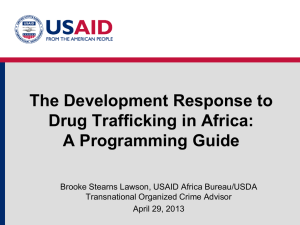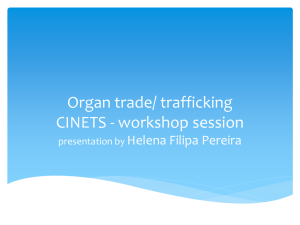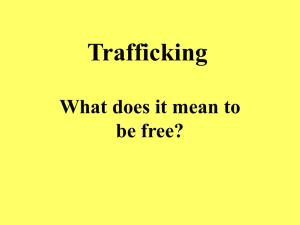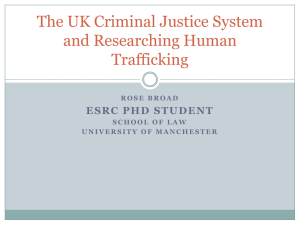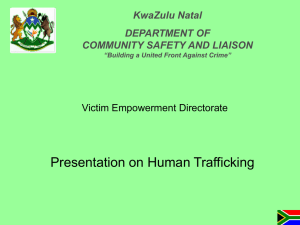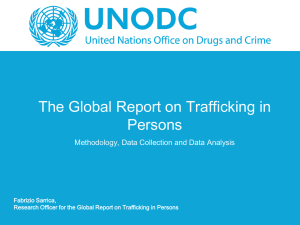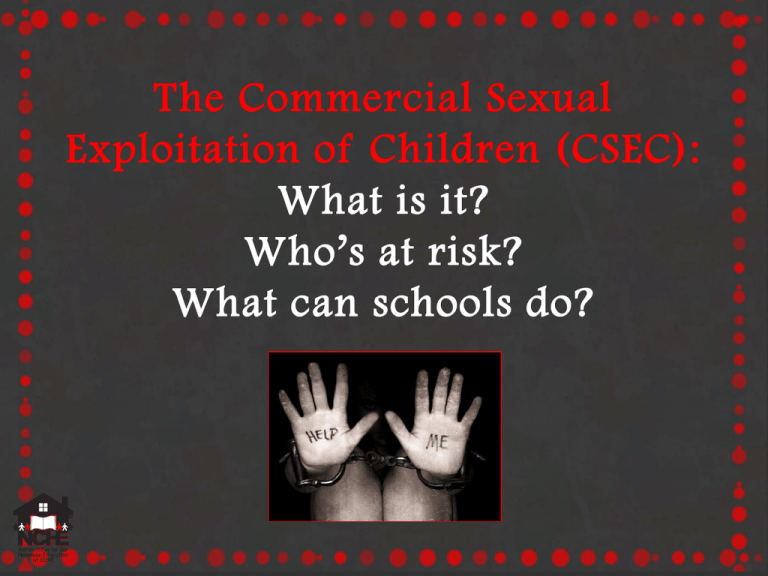
The Commercial Sexual
Exploitation of Children (CSEC):
What is it?
Who’s at risk?
What can schools do?
Why Trafficking?
• Homeless youth, especially unaccompanied
homeless youth, fall squarely within the high-risk
profile for trafficking victims
• Statistics reveal that runaway and homeless youth
are targeted frequently by traffickers
• Schools are being used as recruiting grounds
Sex trafficking in the USA hits close to home
http://www.usatoday.com/story/news/nation/2012/09/26/sextrafficking-in-the-usa/1595489/
What is Human Trafficking?
• One of the fastest growing and most profitable
criminal industries in the world
• An issue of international and domestic concern
– Trafficking of minors in other countries
– Trafficking of foreign youth into the United States
– Trafficking of domestic youth throughout the United States
• Polaris Project:
http://www.polarisproject.org/humantrafficking/overview
What is Human Trafficking?
• Most common forms:
– Trafficking for the purposes of sexual exploitation (~79%
globally)
– Trafficking for the purposes of forced labor (~18% globally)
– http://www.unodc.org/unodc/en/humantrafficking/global-report-on-trafficking-in-persons.html
The Administration’s Position
• December 2012 Presidential Proclamation:
– Designated January 2013 as National Slavery and Human
Trafficking Prevention Month
– “One of the greatest human rights abuses of our time”
– “A crime that amounts to modern-day slavery”
– Press release: http://www.whitehouse.gov/the-pressoffice/2012/12/31/presidential-proclamation-nationalslavery-and-human-trafficking-prevent
The FBI’s Position
• Among children and teens living on the streets in the United
States, involvement in commercial sex activity is a problem of
epidemic proportion.
• Girls living on the street may trafficked locally or become
entangled in organized crime networks where they are
trafficked nationally
• Average age of becoming a victim of sex trafficking:
– Girls: 12-13
– Boys and transgender youth: 11-13
• http://www.fbi.gov/stats-services/publications/lawenforcement-bulletin/march_2011/human_sex_trafficking
Federal Law and Definitions
• Victims of Trafficking and Violence Protection Act of
2000 (TVPA)
– Sex Trafficking: The recruitment, harboring,
transportation, provision, or obtaining of a person for the
purpose of a commercial sex act
– Commercial Sex Act: Any sex act on account of which
anything of value is given to or received by any person
Federal Law and Definitions
• Victims of Trafficking and Violence
Protection Act of 2000 (TVPA)
– Severe Forms of Trafficking: Sex
trafficking in which a commercial sex
act is induced by force, fraud, or
coercion, or in which the person
induced to perform such act has not
attained 18 years of age
• Full text:
http://www.state.gov/documents
/organization/10492.pdf
What Do You Think?
By show of hands, is this sex trafficking?:
A. A 13 year-old homeless youth performing a sex act
for a place to sleep
B. A mother trading a night with her 12-year-old son
for drugs
C. A 14-year-old posing for explicit photos for food
D. A little league coach sexually abusing players
E. A gang member providing fellow members a “girl to
have fun with” for higher status in the gang
The Numbers
• 2010 Congressional Testimony, NCMEC President
– Estimates vary between 100,000-300,000 youth victims of
CSEC each year in the USA
– The number of 10-17 year olds involved in CSEC in the
United States each year likely exceeds 250,000; 60% of
these victims are runaway, thrownaway, or homeless
youth
– Estimates that as many as 1/3 of teen
runaways/thrownaways will become involved in
prostitution within 48 hours of leaving home
– http://www.missingkids.com/missingkids/servlet/NewsEve
ntServlet?LanguageCountry=en_US&PageId=4312
Where is it happening?
•
•
•
•
•
•
•
FBI: 13 High Intensity Child Prostitution Areas:
• San Francisco, CA
Los Angeles, CA
• San Diego, CA
Minneapolis, MN
• Miami, FL
Dallas, TX
• New York, NY
Detroit, MI
• Washington, DC
Tampa, FL
• Las Vegas, NV
Chicago, IL
• St. Louis, MO
http://www.justice.gov/oig/reports/FBI/a0908/chapter4.htm
Urban? Suburban? Rural?
• More youth are exploited in the U.S. sex industry in
urban areas, though they may be brought from
suburban and rural areas.
• However, an increase in minor arrests in suburban
and rural areas has experts speculating that CSEC is
expanding beyond city limits.
• US HHS
http://aspe.hhs.gov/hsp/07/humantrafficking/litrev/
What does it look like?
•
•
•
•
•
•
•
•
•
•
Street prostitution
Escort services
Pornography
Strip clubs
“Massage parlors”
Phone sex lines
“Private parties”
Gang-based prostitution
Cyber market (craigslist, backpage.com, social media)
Truck stops
Who trafficks?
•
•
•
•
•
•
Individual Pimps
Gangs and criminal networks
Brothel and fake massage parlor owners
Intimate partners
Family members
People from all walks of life
Who are the Victims?
• Traffickers are masters of
manipulation and exploiting
vulnerabilities
–
–
–
–
–
–
Target at-risk populations
Threats
Physical harm
Emotional manipulation
“Trauma bond”
Brainwashing
• Any child may be trafficked, but a
profile of a high-risk youth has
emerged…
Victim Risk Factors
•
•
•
•
•
•
•
Poverty
History of sexual or physical abuse
History of family or individual substance abuse
Loss of a parent or caregiver
Running away/being thrown away
Lack of a support system
Special education needs
Victim Risk Factors
• “The themes of trauma, abandonment, and
disruption, begun in childhood, are central to the
narratives of adolescent girls trafficked into
commercial sexual exploitation. Girls describe having
had a profound sense of being alone without
resources.”
• http://aspe.hhs.gov/hsp/07/humantrafficking/litrev/
Who does this sound like?
• Homeless youth, especially UHY
• Youth with child welfare involvement
Warning Signs
• Unexplained school
absences/irregular school
attendance
• Chronic running away
• References frequent travel to other
cities
• Bruising/signs of physical trauma
• Signs of emotional distress, including
depression, withdrawn behavior, and
anxiety
Warning Signs
•
•
•
•
•
Unusual attachment to cellphone
Strange tattoos
Inappropriate dress
Sudden change in material possessions
References to sexual situations beyond what is
appropriate for their age
• “A reputation”
• A noticeably older “boyfriend”
What Can Schools Do?
• Educate staff
• Implement and enforce a policy for reporting
– Partner with law enforcement
– Partner with child welfare
• Train counselors/social workers on how to work with
CSEC victims
• Offer a developmentally appropriate prevention
curriculum to students
Sample Protocol – Grossmont Union High
School District, San Diego
More Information
• FBI | Innocence Lost: www.fbi.gov/aboutus/investigate/vc_majorthefts/cac/innocencelost
• Department of Justice | Human Trafficking:
www.justice.gov/archive/olp/human_trafficking.htm
• US ED | Trafficking Fact Sheet:
www2.ed.gov/about/offices/list/oese/oshs/factsheet.ht
ml
• NCHE | Trafficking:
www.serve.org/nche/ibt/trafficking.php
• FAIR Girls (DC): www.fairgirls.org
• GEMS (NYC): www.gems-girls.org
http://archive.acf.hhs.gov/trafficking/about/form.htm
Questions?
Contact Information
• Christina Dukes, Program Specialist
National Center for Homeless Education (NCHE)
cdukes@serve.org
• Eve Birge, US ED OSHS Liaison on Domestic Human
Trafficking and Gender-based Violence, detailed to
the Office on Violence Against Women, US DOJ
eve.birge@usdoj.gov



